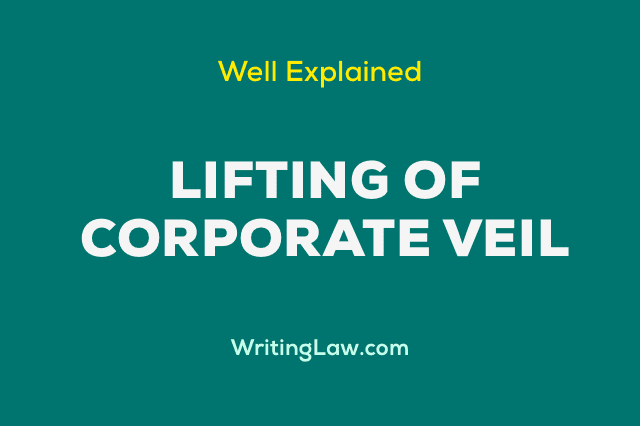
- Lifting of Corporate Veil – Introduction
- When corporate veil shall be lifted?
- When courts can neglect the distinct personality of a company?
Lifting of Corporate Veil – Introduction
A company is distinct from its members. It is a separate legal entity. There is, consequently, a veil between a corporation and its members, keeping them both detached from each other for better legal clarity in terms of overriding rights, duties and obligations. Nevertheless, occasionally it becomes obligatory to lift this veil, neglect the corporation’s distinct corporate entity, and discover the authenticity of the company.
The court may examine the factual affairs, ownership, etc., of the company. This is recognised as lifting or piercing the corporate veil.
In a supplementary interpretation, the court inspects the factual state of dealings of the company. It has been observed that though a corporation is a diverse entity, yet in certainty, it is an association, or simply put, a group of people who are, in fact, unified as the beneficial owners of the existing corporate property.
The corporate veil is lifted by the court when it overlooks the company’s identity and concerns itself directly with the members or managers. It is principally at the discretion of the court and will depend upon the fundamental, social, economic and moral factors as they function in and through the corporation.
The corporate veil is lifted when in defence proceedings. For example, in the case of tax evasion, an entity relies on its corporate personality as a shield to cover its wrongdoings. BSN (UK) Ltd. and Others vs Janardan Mohandas Rajan Pillai (1996).
Nevertheless, the shareholders are not to question the lifting of the veil for personal motives or intentions. This was held in Premlata Bhatia vs Union of India (2004), where a shop’s premises were prearranged on a licence to the individual licensee. She set up a solely owned private company and transferred the premises to that company without the Government’s consent. She could not eliminate the illegality by claiming that she and her company were virtually the same people.
When corporate veil shall be lifted?
The corporate veil shall be lifted in the following occurrences:
- To investigate the relationships between the holding company and the subsidiary company;
- To investigate the figure and titles of members of the company;
- To investigate the true proprietorship of shares and regulatory power over the company;
- To investigate legal substances of the company;
- To investigate maladministration and subjugation by the majority;
- To investigate the atmosphere of the corporation where it is trading with an alien enemy or persons dealing with the affairs of the company are under the control of enemies or be residing in the enemy country;
- To investigate the activities where there exists a tendency to create a monopoly;
- To investigate the corporation activities where there is a possibility for tax evasion or an intention to evade tax obligation;
- To investigate if the company is acting as an agent for its shareholders; To investigate the affairs where it is formed for fraudulent purposes, to overthrow and circumvent the regulation or to defraud its creditors or to evade binding responsibilities.
The Companies Act, 2013 comprises a few provisions {Sections 7(7), 251(1), and 339)} that lift the corporate veil to grasp the real forces of action.
Section 7(7) discusses the punishment for the incorporation of a company by furnishing false information. At the same time, Section 251(1) provides for the liability for making a fraudulent application for removal of the name of the company from the register of companies. Moreover, section 339 puts forth the liability for fraudulent conduct of business during winding up.
From the time the decision in Salomon vs Salomon & Co. Ltd., (1897), was passed, the courts have become reluctant or, at the slightest, very vigilant to lift the veil of the company’s authentic personality and to see the real individuals behind it.
When courts can neglect the distinct personality of a company?
Nonetheless, courts have established it necessary to neglect the distinct personality of a company in the following state of affairs:
- Wherever the corporate veil has been cast off for a directive of fraud or inappropriate demeanour. In such a circumstance, courts have lifted the veil and beheld the realism of the situation.
- Wherein, a corporate disguise is actually only agency instrumentation.
- Where the comportment conflicts with the public policy, courts lifted the corporate veil to shield public policy.
In Inalsa Ltd. vs Union of India (1996), it was held that it was permitted and acceptable for the court to lift the veil of any corporation to see whether it was a subsidiary of another company.
- What is the Principle of Res Ipsa Loquitur – Indian Evidence Act - 6th April 2021
- Lifting of Corporate Veil - 23rd March 2021
- 10 Types of Evidence Under the Indian Evidence Act - 13th March 2021







